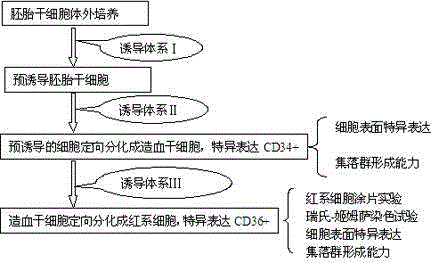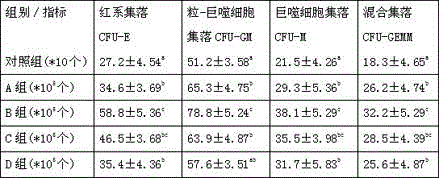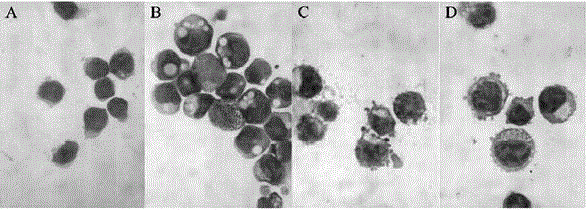Method for inducing embryonic stem cells to be differentiated into erythroid cells in vitro
A technology of embryonic stem cells and erythroid cells, which is applied in the field of in vitro induction of embryonic stem cells to differentiate into erythroid cells, can solve the problems of poor stability of hemoglobin oxygen carriers, weak oxygen-carrying capacity of fluorocarbons, complex process, etc., and achieve effective cell sources , easy to obtain materials, and easy to amplify in vitro
- Summary
- Abstract
- Description
- Claims
- Application Information
AI Technical Summary
Problems solved by technology
Method used
Image
Examples
specific Embodiment 1
[0035] Specific example 1: in vitro induction of embryonic stem cells to differentiate into erythroid cells
[0036] (1) Routine culture of embryonic stem cells, the specific steps include:
[0037] Embryonic stem cells are routinely cultured for passage and expansion. The medium at this stage is: 85% DMEM medium as the basal medium, supplemented with 15% Knockout Serum Replacement, 1mmol / L essential amino acids, 100IU / mL penicillin, 50μg / mL streptomycin and 4ng / mL bFGF. Cell cultures were incubated at 37°C, 5% CO2, and passaged once a week.
[0038] (2) Pre-induction of embryonic stem cells, the specific steps include:
[0039] In order to induce the differentiation of human embryonic stem cells into hematopoietic cells, the embryonic stem cells were induced for 6-7 days in culture. Digest with 1 mg / mL type Ⅳ collagenase at 37°C for 3-5 minutes and pipette into small cell clusters, then use ultra-low adhesion 6-well culture plates to suspend for 7 days, use 100 IU / mL penic...
specific Embodiment 2
[0048] Specific embodiment 2: the mensuration of each index of hematopoietic stem cell
[0049] (1) Specific expression on the cell surface: detection of specific markers of hematopoietic stem cells
[0050] CD34 antigen is a glycoprotein with a molecular weight of 115kD on the cell surface. The gene encoding CD34 is located on the long arm of chromosome 1 and contains 8 exons. CD34 antigen is a differentiation group antigen present only on the surface of hematopoietic stem / progenitor cells. CD34 is strongly positively expressed on hematopoietic stem cells, but weakly positive on late-differentiated progenitor cells. Mature blood cells do not express the CD34 antigen. Therefore, CD34 can be used as a basic marker for detecting hematopoietic stem cells.
[0051] Take the well-growth cells from step (3) of Example 1 for detection: collect, centrifuge at 1500rpm for 10min, discard the supernatant, add PBS solution to resuspend, draw 100μL of cell suspension (about 3×10 5 cel...
specific Embodiment 3
[0056] Specific embodiment 3: the determination of various indexes of erythroid cells
[0057] 1. Erythroid cell smear test
[0058] (1) Collect the suspension-cultured cells at different time points in step (4) of Example 1, centrifuge at 2000 rpm for 5 minutes. Discard the supernatant, add 1ml PBS to wash the cells twice. Resuspend the cells to 100 μl;
[0059] (2) The slides were soaked in acid solution, rinsed repeatedly with distilled water, and coated with poly-lysine. Install it on the cell smear machine according to the operating instructions, and mark it with a pencil;
[0060] (3) Add the cell suspension, set the speed of the cytocentrifuge to 1000 rpm, and centrifuge for 2 minutes. After centrifugation, separate the middle filter paper layer from the slide in a vertical direction, carefully remove the slide, and dry the slide.
[0061] The results showed that the hematopoietic stem cells grew in suspension in the erythroid induction medium and expanded rapidly...
PUM
 Login to View More
Login to View More Abstract
Description
Claims
Application Information
 Login to View More
Login to View More - R&D
- Intellectual Property
- Life Sciences
- Materials
- Tech Scout
- Unparalleled Data Quality
- Higher Quality Content
- 60% Fewer Hallucinations
Browse by: Latest US Patents, China's latest patents, Technical Efficacy Thesaurus, Application Domain, Technology Topic, Popular Technical Reports.
© 2025 PatSnap. All rights reserved.Legal|Privacy policy|Modern Slavery Act Transparency Statement|Sitemap|About US| Contact US: help@patsnap.com



